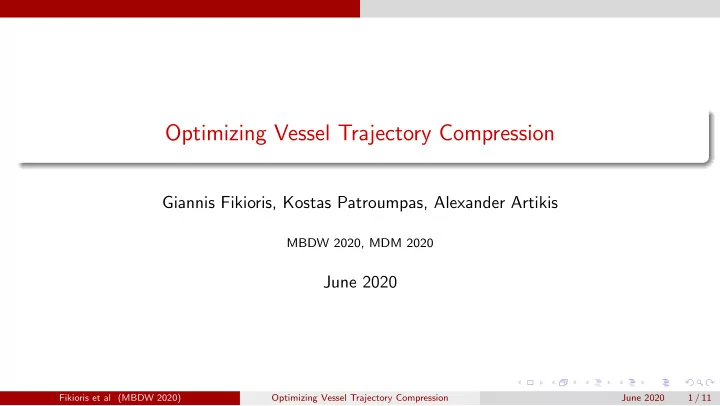

Optimizing Vessel Trajectory Compression Giannis Fikioris, Kostas Patroumpas, Alexander Artikis MBDW 2020, MDM 2020 June 2020 Fikioris et al (MBDW 2020) Optimizing Vessel Trajectory Compression June 2020 1 / 11
Outline Online Summarization of Vessel Trajectories 1 Fine-Tuning of Compression Parameters 2 Empirical Analysis 3 Future Work 4 Fikioris et al (MBDW 2020) Optimizing Vessel Trajectory Compression June 2020 2 / 11
Online Summarization of Vessel Trajectories Vessel Trajectory Compression Single-pass filters to remove noise : duplicate/delayed points, invalid coordinates, etc. Online detection of critical points along the evolving trajectory of a vessel: e.g., stop, turning points, slow motion, etc. Trajectory synopsis : these critical points can approximately reconstruct the original course. The actual course is approximated via time-based interpolation between successive critical points. Fikioris et al (MBDW 2020) Optimizing Vessel Trajectory Compression June 2020 3 / 11
Online Summarization of Vessel Trajectories Compression Parameters Symbol Parameter Angle threshold ( o ) ∆ θ m Buffer size (locations) ∆ T Gap Period (seconds) ω Historical timespan (seconds) v min No speed threshold (knots) v θ Low speed threshold (knots) α Speed ratio D Distance threshold (meters) Custom parametrization is required per dataset, since sampling rates may differ. Different ship types have different motion patterns, e.g., tankers vs. fishing boats. Original parameter values were common for all vessel types and picked after data exploration, using domain expert knowledge. Fikioris et al (MBDW 2020) Optimizing Vessel Trajectory Compression June 2020 4 / 11
Fine-Tuning of Compression Parameters Our Contribution We introduce a method that automatically “learns” the best parameters per vessel type in an AIS dataset. Two variables to minimize: Error , i.e., the RMSE between the original noiseless trajectories and the ones approximately reconstructed from synopses: � p ∈ noiseless points dist 2 ( p , approx ( p )) � RMSE = number of noiseless points for all vessels Compression Ratio of the resulting trajectory synopses: Ratio = number of critical points for all vessels number of noiseless points for all vessels Fikioris et al (MBDW 2020) Optimizing Vessel Trajectory Compression June 2020 5 / 11
Fine-Tuning of Compression Parameters Optimization Function To minimize both objectives we minimize a function of the following form: ( RMSE + r ) n × Ratio where r and n are hyper-parameters. Our goal is to find parameters that keep the value of RMSE tolerable (usually close to the length of a ship) and also minimize the value of Ratio . Fikioris et al (MBDW 2020) Optimizing Vessel Trajectory Compression June 2020 6 / 11
Fine-Tuning of Compression Parameters Optimization Algorithm We employ a genetic algorithm (GA) that iterates over several combinations of the compression parameter values, to minimize the optimization function. To set the hyper-parameters, we train the GA for different combinations of r and n to find values so that the resulting RMSE and Ratio are below certain thresholds. Fikioris et al (MBDW 2020) Optimizing Vessel Trajectory Compression June 2020 7 / 11
Empirical Analysis Empirical Setup To test the GA we used the Brest dataset, training it on the ship types with the most AIS messages. For each ship type we did a 6-fold cross validation. Fikioris et al (MBDW 2020) Optimizing Vessel Trajectory Compression June 2020 8 / 11
Empirical Analysis Brest Dataset - Information Brest dataset information Threshold Hyper-parameters Training Cost (5/6 of the points) Vessel type AIS messages Vessel count RMSE Ratio r n Mean time ± Std deviation Passenger 4,792,487 17 30m 10% 17 0.8 5.2 hours ± 16 minutes Unknown 3,466,765 115 15m 15% 10 1.0 4.5 hours ± 8 minutes Fishing 3,288,577 161 30m 30% 17 0.7 4.5 hours ± 39 minutes Tug 1,411,761 15 15m 15% 2 1.6 1.8 hours ± 4 minutes Cargo 1,198,228 184 30m 10% 13 0.8 1.5 hours ± 2 minutes Military 802,045 12 15m 15% 10 1.4 1 hour ± 3 minutes Fikioris et al (MBDW 2020) Optimizing Vessel Trajectory Compression June 2020 9 / 11
Empirical Analysis Brest Dataset - Results (a) Passenger Ships (b) Unknown Type (c) Fishing Boats (d) Tug Boats (e) Cargo Ships (f) Military Vessels Fikioris et al (MBDW 2020) Optimizing Vessel Trajectory Compression June 2020 10 / 11
Future Work Future Work Evaluate the performance of the new synopses on recognizing complex events. Introduce new methods for better/faster optimization. Fikioris et al (MBDW 2020) Optimizing Vessel Trajectory Compression June 2020 11 / 11
Recommend
More recommend